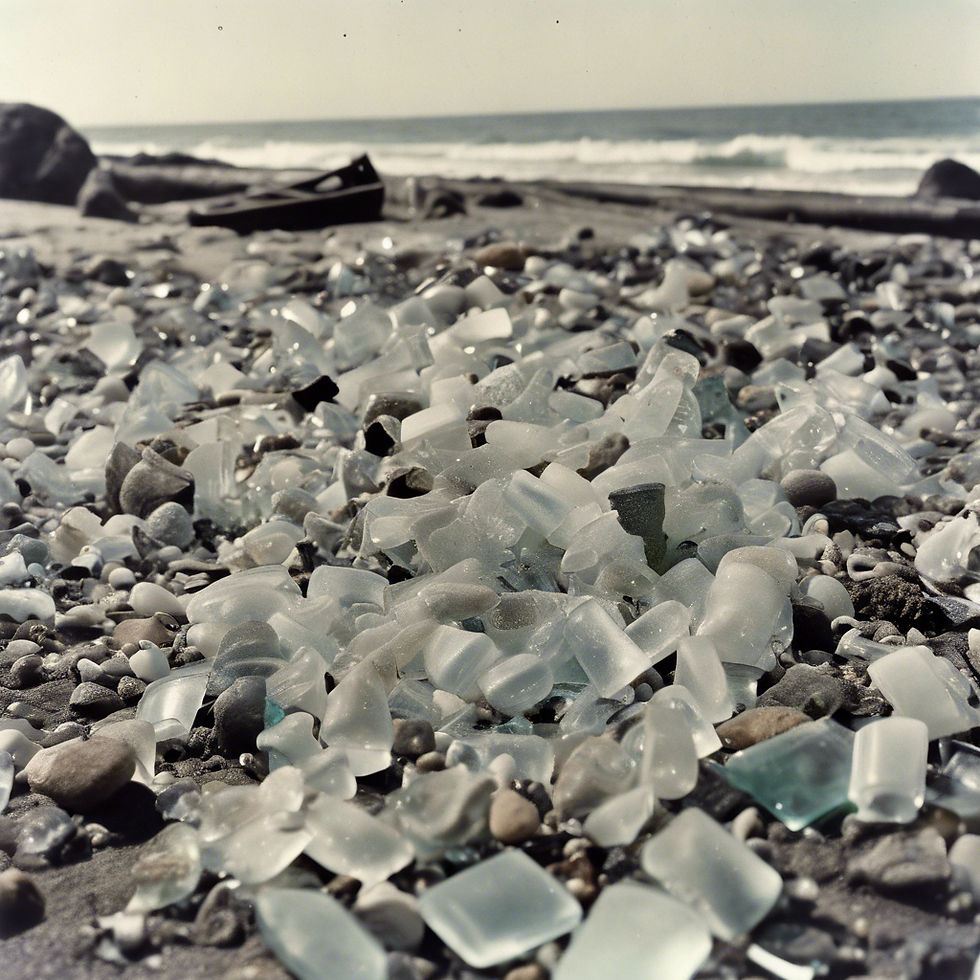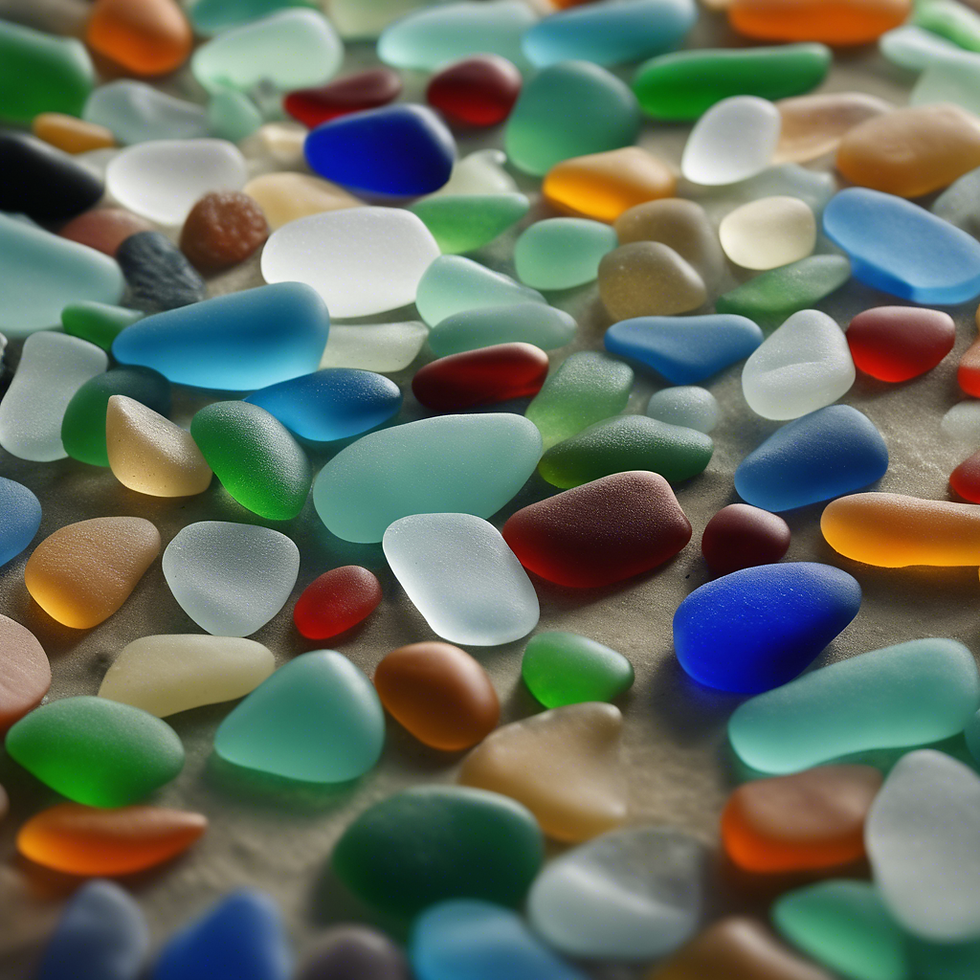The Journey of Sea Glass: From Shoreline to Treasure
- Caitlin Brown
- Oct 2, 2024
- 6 min read
Sea glass is a stunning natural gem, worn smooth by the waves and tides over decades or even centuries. Each piece of sea glass carries a unique story, from its origins as discarded glass to its eventual transformation into a jewel of the sea. It’s a journey marked by time, patience, and the powerful forces of nature, and this story is as captivating as the glass itself. In this blog, we’ll take you through the lifecycle of sea glass, from how it ends up in the ocean, to its transformation into smooth, frosted treasures, and where these pieces are most commonly found.
How Does Glass End Up in the Ocean? The Journey of Sea Glass:
The journey of sea glass begins, surprisingly enough, with human carelessness. Glass can end up in the ocean in many ways, often as discarded trash. Historically, coastal areas were used as dumping grounds for waste, especially before regulations were in place to prevent pollution. Broken bottles, jars, and even pieces of glass from shipwrecks found their way into the water, where they started a long process of transformation.
Coastal Communities and Glass Disposal
In the past, coastal towns would dump garbage, including glass, into the sea as a convenient method of disposal. For decades, glass items such as soda bottles, beer bottles, windows, and medicine bottles were tossed into rivers and oceans. With time, these broken pieces would sink to the seabed, destined to be worn by the sea's elements.
Shipwrecks and Maritime Disasters
Another source of sea glass comes from shipwrecks. When a ship sinks, its cargo—often including bottles, windows, and other glass items—may break apart as it crashes against rocks or reefs. Over time, the remnants of the wreck wash ashore or remain submerged, creating an underwater haven for sea glass to be formed. This is why certain coastal areas near shipwreck sites are treasure troves for sea glass hunters.
Modern-Day Pollution
Even today, despite stricter environmental regulations, glass still occasionally ends up in the ocean through littering or as a result of storms and floods washing debris into waterways. Though the majority of sea glass found today is the result of glass discarded many years ago, new pieces are continually being added to the ocean.
The Tumbling Process: How Nature Shapes Sea Glass
Once glass enters the ocean, the next stage of its journey begins: the slow, natural process of being tumbled and shaped by the elements. What starts as sharp, jagged shards of broken glass undergoes a dramatic transformation, thanks to the constant motion of the ocean and the friction of sand and rocks. Over time, the glass becomes smooth, frosted, and rounded—characteristics that make it recognizable as sea glass.
Wave Action and Tidal Movement
The ocean’s currents and tides play a significant role in the creation of sea glass. Waves crashing on the shore or stirring the seabed cause pieces of glass to collide with rocks, sand, and each other. This constant friction smooths out sharp edges and eventually gives the glass its signature frosted appearance.
The Role of Sand and Rocks
Sand, made up of tiny particles of rock, acts like a natural abrasive. It polishes the glass as it tumbles along the seabed, slowly wearing down the surface of each shard. Over the years, this friction breaks down the sharp corners of the glass, turning it into the soft, pebble-like shapes that are so prized by collectors.
Time is Key
Sea glass doesn’t form overnight. Depending on the size and shape of the original glass, it can take anywhere from 20 to 100 years (or even longer) for a piece of glass to become smooth and frosted enough to be considered true sea glass. During this time, the glass may drift long distances, carried by ocean currents, before eventually washing up on shore.
Weathering and Frosting
The distinctive frosted look of sea glass comes from a process known as chemical weathering. Saltwater, in combination with the constant tumbling, slowly erodes the surface of the glass, creating tiny pits and scratches that diffuse light, giving the glass its soft, matte finish.
Where is Sea Glass Most Commonly Found?
Sea glass can be found on beaches all over the world, but certain areas are known to be particularly abundant in these natural treasures. Typically, sea glass is found in regions with a history of glass manufacturing, maritime activity, or areas that were once used as dumping grounds for waste.
Popular Sea Glass Beaches
Some beaches are famous for their abundance of sea glass, attracting collectors from all over the globe. Some of the best-known sea glass hotspots include:
Glass Beach, California (USA): One of the most famous sea glass beaches in the world, Glass Beach was once a dumping ground for trash. Over the years, waves have broken down the glass debris, and now the beach is covered in a rainbow of sea glass pebbles.
Seaham, England (UK): Seaham Beach is renowned for its beautiful, multi-coloured sea glass, a remnant of the glass factories that once operated in the area. It’s one of the few places where collectors can find rare “end of day” glass, which consists of vibrant, mixed-colour pieces.
Fort Bragg, California (USA): Like Glass Beach, Fort Bragg was a dumping ground in the early 20th century. Today, it’s a popular destination for sea glass enthusiasts, known for its abundant blue, green, and white glass pieces.
Coastal Regions with Historical Dumping Grounds
Beaches near towns or cities with a history of glass production or maritime industries tend to have more sea glass. Coastal regions with old bottle factories, seaports, or even pirate activity can be treasure troves for sea glass. For example, New England’s rocky shores often yield impressive collections due to their long history of shipping and fishing industries.
Shipwreck Sites
As mentioned earlier, areas near known shipwreck sites often produce sea glass, especially around coral reefs or rocky coastlines. Shipwrecks can contain not only bottles but also glass artifacts, which are broken down over time and transformed into sea glass.
Hidden Gems: Lesser-Known Beaches
While some beaches are well-known for their sea glass, others remain hidden gems. These spots are often located off the beaten path and require some exploration to find. However, collectors willing to go the extra mile are often rewarded with unique, rare pieces of sea glass in a wide range of colours.
Rare and Unique Colours of Sea Glass
One of the most exciting aspects of collecting sea glass is discovering rare or unusual colours. Most sea glass is found in shades of green, brown, and clear, which come from common glass bottles and jars. However, there are rarer colours that collectors treasure.
Common Colours
Green, brown, and white sea glass is the most common, as these colours come from beer bottles, soda bottles, and food jars.
Rare Colours
Blue: Blue sea glass comes from old medicine bottles, ink bottles, and occasionally decorative glass. It’s highly sought after by collectors because it’s much less common than green or brown glass.
Purple: Once a rare find, purple sea glass is becoming more common. It was often made from glass that contained manganese, which turns purple after prolonged exposure to sunlight.
Red and Orange: These are some of the rarest colours of sea glass, often coming from old tail lights, decorative glassware, or specialized industrial glass.
Multi-Coloured Sea Glass
In some cases, sea glass comes in mixed or swirled colours, known as “end of day” glass. This type of sea glass is rare and is typically found in areas with a history of glass production, where leftover bits of molten glass were discarded into the ocean.
The Allure of Sea Glass in Jewelry
The transformation from broken glass to smooth, polished sea glass is part of what makes these pieces so appealing as materials for jewelry. Each piece of sea glass is a one-of-a-kind gemstone, shaped by nature and imbued with a sense of history and mystery.
For artisans, sea glass offers a way to create beautiful, sustainable jewelry with a story. Each piece holds a connection to the ocean, to a forgotten past, and to the powerful forces of nature that shaped it. Whether set in silver, incorporated into pendants, or used in earrings, sea glass is cherished not only for its beauty but for the journey it represents.
Conclusion
The journey of sea glass, from discarded glass to a beautifully polished gem of the sea, is a story of transformation. From the moment a piece of glass is tossed into the ocean, it embarks on a long, slow journey through time, shaped by the waves, rocks, and sand until it finally washes up on shore as sea glass. These naturally tumbled treasures are found all over the world, each piece a reminder of the power of nature to turn the mundane into the extraordinary. Whether you’re a collector, a jewelry maker, or simply an admirer of the ocean, the allure of sea glass lies in its beauty, its rarity, and the mystery of its journey.
At Fundy Bay Treasures, we preserve memories with every piece, one gem at a time with our jewelry that's uniquely you.








Comments